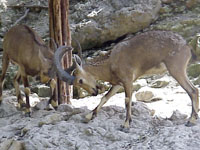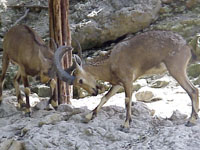
Nubian Ibexes in Yemen: Where Are They? [Archives:2007/1076/Last Page]
August 13 2007
 |
Last month, the Environmental Protection Authority in Sana'a was informed by a local citizen about major Nubian ibex traces found in certain regions in Al-Jawf governorate, located northeast of Sana'a.
Despite the importance of this information, few field environmental surveyors wanted to follow up on the report. Among the excuses given were: the area is far away, there is no proper transportation to the location and the information could be false. Mohammed Juman, a field surveyor for the authority, decided to carry out this mission, believing that this trip would lead him to a very important discovery.
Unwilling to go alone, he entrusted Hadi Mohammed Wasan, the local citizen who informed authorities about the existence of ibexes in the region. They used Juman's digital camera and borrowed binoculars from the locals. Such limited tools only enabled Juman to watch and observe certain regions.
“As I arrived in the region, I noted that the site proposed for studies was located within a rugged mountainous area and surrounded by rocky land empty of the population residence. Moreover, human activities were not found inside the site or in the neighboring area until reaching the small areas inhabited by some traveling nomads. These residential areas are built of clay and pieces of wood, small cottages scattering through the valley covered with grass and dominated by agricultural activities,” Juman recalled.
However, that which attracted Juman's attention was the plethora of dead ibex bodies in the region. “The hunting processes of Nubian ibexes existing in this area continue until now,” he explained, adding that such hunting activity is not as intense as in previous decades, the most activity occurring during the drought period which caused ibexes to approach residential areas seeking water. After a short period of this drought, in the beginning of nineties, the ibexes began to return to their natural habitat. Consequently, hunting processes were minimized due to difficulties faced in locating ibexes.
“It was noticed that a large number of citizens who practice hunting are of low income. The ostensible purpose of hunting such animals, as they pretend, is to get benefits from their big size as well as their good taste. However, some citizens have said that the main purpose behind hunting is to earn money in order to increase their income through chasing these big animals and catching them without any harm. This process may happen in the wilderness during the drought period when these animals get down to the opened lands neighboring the site. The citizens chase animals using fast vehicles to catch them. Some citizens mentioned that this process had taken place two years ago. They caught animals and sold them to one of the Gulf countries,” Juman stated, confirming that the cost of one ibex, which was classified as “endangered” (EN C2a) on the 2004 IUCN (World Conservation Union) Red List, is estimated between $500 to $1000.
“However, catching newborns is done through taking them from their living environment during the delivery process or through killing their mother. Four cases were reported. One of them was through killing their mother,” Juman added.
In regard to hunting through sniping or shooting, at least 50 cases were reported within the same site during the last two decades. Ibexes are snipped by the area's citizens, visiting hunters from inside the country or from neighboring countries. According to Juman, the last hunting process took place last week before the survey team arrived to the area. “It [hunting] was done by visitors of the neighboring countries. Two Arabian ibexes were hunted,” he reported.
Despite the dramatic scene of ibex bones that were spread throughout many zones, Juman did not give up. He insisted on completing his mission with the hope that he could find surviving ibexes. His hopes came to fruition. “On the first day of the team surveying proposed sites belonging to Al-Hazm district, the team could catch sight of a flock of Arabian ibex consisting of six females headed by one male crossing the area via mountainous series belonging to Al-Louth Mountain in the eastern direction. The flock also passed through the plain known as the watercourse where water filters between rocks due to rainfall in the area. They stayed there for 15 minutes behind trees and rocks. They left the place crossing the rocky slope. Some photos were taken of these animals while they were eating grass in the area,” Juman revealed.
According to Juman, such observations will help to prove the existence of Arabian ibexes in several mountainous regions surrounding the observation site. He went on to say that such a discovery must be taken into consideration to declare the region as a protected area for ibex preservation, as these animals are exposed to hunting by local citizens as well as visitors coming from surrounding areas or neighboring countries.
Answering the question of the importance of saving these animals, Juman stated, “Currently, we observe that the situation of the Arabian ibex living in the Republic of Yemen appears to be uncertain or possible to survive for a long time in the future. This is due to the straitened circumstances it lives in. The Nubian ibex, which is also called “capra Nubiana,” faces pressures and direct threats subjecting it to extinction in the short term due to the increasing growth of hunting as well as the continuation of chasing and disturbance. Moreover, the females of this animal are exposed to killing and their newborns are taken away. The natural living environment of this animal is destroyed.”
He continued, “As a result of the continuation of these inhumane acts against this kind of wild animal directed without any proper observation or protection and organizing the periods of hunting, it may cause growing concerns regarding the decrease of this animal in its spreading places. This is especially in the last decades, [ibexes] reaching to remarkably small numbers or may be hardly found in their natural environments.” Juman mentioned that surveys in several areas within Hadhramout, known to house Arabian ibexes, were conducted by the General Authority for Environmental Protection in cooperation with the authority of environment and natural protectorates in Al-Shariqah in 2005 in order to assess the current situation of this animal in those areas. No Arabian ibexes were spotted during the survey, however, the survey team found traces of the ibex as well as its waste in different sites.
“All of these findings indicate the rarity of these ibexes in the area. The animal is threatened by extinction, if we continue ignoring this problem and do nothing to reduce the dangers facing this wild animal in Yemen,” Juman concluded.
——
[archive-e:1076-v:15-y:2007-d:2007-08-13-p:lastpage]


